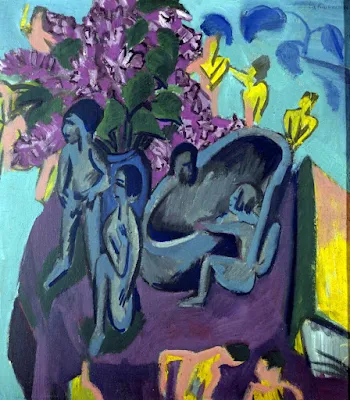Expressionism is one of my favorite artistic styles. It is a subjective art form with an emotional and spiritual view of the world. The term often implies emotional angst or intense emotion. The artist has the tendency to distort reality for an emotional effect, using a two-dimensional view without perspective. They use highly charged brushstrokes with contrasting bold colors.
Ernest Ludwig Kirchner (1880 - 1938) was born in Aschaffenburg in 1880, he is now extensively recognized as the greatest artist of German Expressionism.
 (Kirchner, Ernest Ludwig. Still-life with Flowers and Sculptures. c. 1912. Oil on canvas, 90 x 78.3 cm.)
(Kirchner, Ernest Ludwig. Still-life with Flowers and Sculptures. c. 1912. Oil on canvas, 90 x 78.3 cm.)
Kirchner moved to Berlin in 1911. He became very fond of Berlin’s urban scenery and social settings, especially focusing on the individual within the large city.
 (Kirchner, Ernest Ludwig. Two Women in the Street.
c. 1914. Oil on canvas, 96.4 x 72.8 cm.)
(Kirchner, Ernest Ludwig. Two Women in the Street.
c. 1914. Oil on canvas, 96.4 x 72.8 cm.)
Just as the industrial revolution was getting underway, he painted with crude brushstrokes and thickly applied radiant bright colors capturing all the glamour of Berlin's elite society on canvas. He was heavily influenced by tribal art and African masks, often using strong elongated angular forms.
 (Kirchner, Ernest Ludwig. Berlin Street Scene.
c. 1913. Oil on canvas, 96.5 x 76 cm.)
(Kirchner, Ernest Ludwig. Berlin Street Scene.
c. 1913. Oil on canvas, 96.5 x 76 cm.)
Kirchner rebelled against the traditional Renaissance masters. He aimed to establish a new aesthetic, which would eventually become the ‘Die Brucke’, translated as ‘The Bridge’. 'The Bridge' was a group of artists, whose philosophy was to connect the art of Germany’s past with that of the future.
 (Kirchner, Ernest Ludwig. Street, Berlin. c. 1913. Oil on canvas, 120.6 x 91.1 cm. The Museum of Modern Art, New York, New York.)
(Kirchner, Ernest Ludwig. Street, Berlin. c. 1913. Oil on canvas, 120.6 x 91.1 cm. The Museum of Modern Art, New York, New York.)
In his bohemian studio space, Kirchner and the other members of 'the Bridge' formulated radical new ideas for art. They drew freely from nude models, who were not professionals. These models were mostly girlfriends or friends from the circle of artists that worked with Kirchner in his studio. Rumors from his studio claimed that there was lots of reckless passionate sex among them.
 (Kirchner, Ernest Ludwig. Three Bathers.
c. 1913. Oil on canvas. Art Gallery of the New South Wales.)
(Kirchner, Ernest Ludwig. Three Bathers.
c. 1913. Oil on canvas. Art Gallery of the New South Wales.)
Kirchner's life took a turn for the worst when he was grudgingly sent to the military during the First World War. He served in the 75th Artillery Regiment and was positioned as field artillery. Soon after, he began to suffer from severe psychological and physical breakdowns.
 (Kirchner, Ernest Ludwig. Self-Portrait as a Soldier. c. 1915.
Oil on canvas, 69.2 x 61 cm. Art Gallery of the New South Wales.)
(Kirchner, Ernest Ludwig. Self-Portrait as a Soldier. c. 1915.
Oil on canvas, 69.2 x 61 cm. Art Gallery of the New South Wales.)
Kirchner contracted lung disease in October 1915 and was discharged from the military. He returned to Berlin, only to find that his life would never completely recover from his experience in the war.
In 1937 the German Nazi party confiscated of all Kirchner’s work and labeled him as a degenerate artist. Without his paintbrush, the use of color, his artistic expression, and living in total isolation, he committed suicide one year later.
 (Kirchner, Ernest Ludwig. Self-Portrait.)
(Kirchner, Ernest Ludwig. Self-Portrait.)
Even though the Nazi party did not appreciate Kirchner’s work, soon after his death, Expressionism began to spread all over Europe and eventually throughout the rest of the world.
Expressionism is a wonderful artistic style. The dramatic colors combined with the passionate brush strokes are truly an inspiration to everyone. I love all of Kirchner's work! He is by far one of my favorite artists and he is very much appreciated here!
Enjoy :)

 (Kirchner, Ernest Ludwig. Two Women in the Street.
c. 1914. Oil on canvas, 96.4 x 72.8 cm.)
(Kirchner, Ernest Ludwig. Two Women in the Street.
c. 1914. Oil on canvas, 96.4 x 72.8 cm.) (Kirchner, Ernest Ludwig. Berlin Street Scene.
c. 1913. Oil on canvas, 96.5 x 76 cm.)
(Kirchner, Ernest Ludwig. Berlin Street Scene.
c. 1913. Oil on canvas, 96.5 x 76 cm.) (Kirchner, Ernest Ludwig. Street, Berlin. c. 1913. Oil on canvas, 120.6 x 91.1 cm. The Museum of Modern Art, New York, New York.)
(Kirchner, Ernest Ludwig. Street, Berlin. c. 1913. Oil on canvas, 120.6 x 91.1 cm. The Museum of Modern Art, New York, New York.) (Kirchner, Ernest Ludwig. Three Bathers.
c. 1913. Oil on canvas. Art Gallery of the New South Wales.)
(Kirchner, Ernest Ludwig. Three Bathers.
c. 1913. Oil on canvas. Art Gallery of the New South Wales.) (Kirchner, Ernest Ludwig. Self-Portrait as a Soldier. c. 1915.
Oil on canvas, 69.2 x 61 cm. Art Gallery of the New South Wales.)
(Kirchner, Ernest Ludwig. Self-Portrait as a Soldier. c. 1915.
Oil on canvas, 69.2 x 61 cm. Art Gallery of the New South Wales.) (Kirchner, Ernest Ludwig. Self-Portrait.)
(Kirchner, Ernest Ludwig. Self-Portrait.)